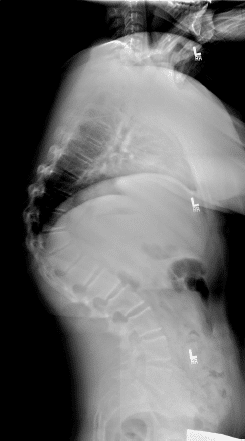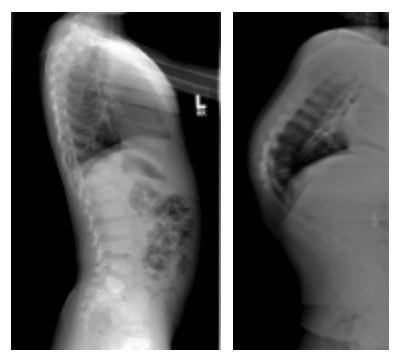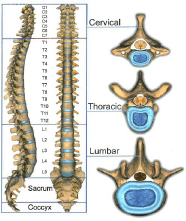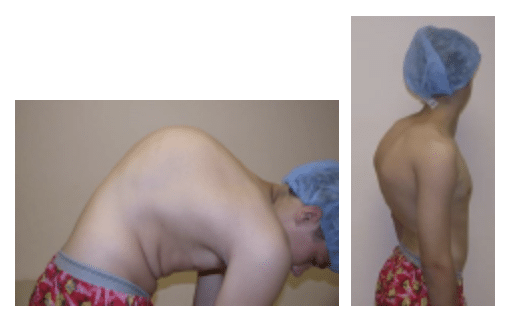
The human spine features several natural curvatures which help our bodies move and remain balanced. The thoracic spine has some degree of a rounded curvature. Kyphosis (or Scheuermann’s Kyphosis) is an abnormally rounded back. It is a condition that may affect children, teenagers and adults.

The cause for Scheuermann’s Kyphosis is unknown. It may be caused by abnormal growth of the vertebra in which the front part stops growing before the back part does. This growth abnormality causes wedge-shaped vertebral bodies, which create an abnormally rounded thoracic spine. It typically progresses during puberty.
Kyphosis may also be caused by vertebral compression fractures (due to tumors or weak bone) or degenerative bone condi-tions, such as arthritis.
Understanding your spine and how it works can help you understand kyphosis.
The spine is made up of small bones, called vertebrae, which are stacked on top of one another. Muscles, ligaments, nerves, and intervetrebal disks are additional parts of the spine.

These bones connect to create a canal that protects the spinal cord. The spinal column is made up of three sections that create three natural curves in the back: the curves of the neck area (cervical), chest area (thoracic), and lower back (lumbar). The lower section of the spine (sacrum and coccyx) is made up of vertebrae that are fused together.
Five lumbar vertebrae connect the twelve thoracic vertebra to the pelvis.
Congenital Kyphosis occurs when the spinal column does not develop properly while the fetus is still in the womb. The vertebrae do not properly form as they should, or some vertebrae may be fused together. The spinal cord may be at risk of injury with congenital kyphosis. Surgery is frequently necessary.
Postural Kyphosis is the most common type of kyphosis. It becomes noticeable during adolescence, is more common among females than males, and rarely causes pain. It is a non-surgical problem.

Scheuermann’s Kyphosis is the most common type of kyphosis often requiring surgery. Boys are affected more often than are girls. The upper back gradually appears more rounded, and there may be accompanying back pain that worsens during the day and is relieved with rest. Pain, if present, is typically felt at the most curved point of the spine and can be aggravated by activity or prolonged periods of sitting or standing. Low back pain also frequently develops.
The distinguishing factor between postural kyphosis and Scheuermann’s kyphosis on physical examination is rigidity of the spine.
The doctor will ask your child to bend forward, to reveal any spinal deformities. This is called the “Adam’s forward bend test.”
Treatment Options
Continually observing a small curve to check for progression as the child or adolescent grows.
Advances in orthotics and prosthetics have led to much more comfortable and lighter weight polypropylene plastic. Unfortunately, to date, no brace has been shown to actually improve kyphosis. That desired outcome is only available via surgical treatment.
The surgical treatment for Scheuermann’s Kyphosis is usually reserved for curves that have progressed beyond 65 degrees. If left untreated, continued progression of these curves may lead to chronic, severe, pain, deformity, psychosocial disability and pulmonary dysfunction.
Congenital kyphosis also often requires opera-tive treatment, usually to protect the spinal cord from injury or relieve it from pressure created by the congenital spinal deformity.